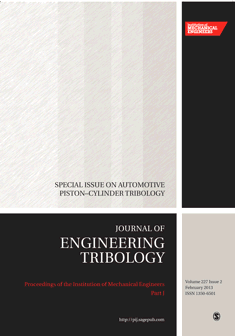
PROCEEDINGS OF THE INSTITUTION OF MECHANICAL ENGINEERS PART J-JOURNAL OF ENGINEERING TRIBOLOGY
Scope & Guideline
Unraveling the complexities of tribology in mechanical systems.
Introduction
Aims and Scopes
- Tribological Modeling and Simulation:
The journal publishes research on various modeling techniques, including finite element analysis, computational fluid dynamics, and machine learning, to predict tribological performance and behaviors in different mechanical systems. - Material Science and Surface Engineering:
A core area of focus includes the study of materials and surface treatments that affect friction, wear, and lubrication. This encompasses investigations into coatings, composite materials, and the development of nanolubricants. - Experimental Investigations:
The journal features empirical studies that explore the tribological properties of materials and lubricants under various conditions, providing insights into wear mechanisms and performance evaluations. - Lubrication Technology:
Research on lubrication systems, including both traditional and innovative lubrication methods, is a significant focus area. This includes studies on bio-lubricants, nanolubricants, and the impact of lubricant formulations on performance. - Applications in Mechanical Systems:
The journal emphasizes the application of tribological principles to real-world mechanical systems, including bearings, gears, seals, and automotive components, highlighting the practical implications of the research.
Trending and Emerging
- Sustainable and Eco-friendly Lubrication Solutions:
Research into bio-lubricants and environmentally friendly lubrication solutions is gaining momentum, driven by the need for sustainable practices in engineering and manufacturing. - Nanotechnology in Tribology:
The use of nanomaterials and nanolubricants is trending, with studies focusing on their unique properties and potential to enhance lubrication performance and reduce wear. - Machine Learning and AI Applications:
The integration of machine learning and artificial intelligence in predicting tribological behaviors and optimizing lubrication systems is emerging as a significant trend, facilitating data-driven approaches in research. - Advanced Coatings and Surface Treatments:
There is a growing interest in developing advanced coatings and surface modifications, including textured surfaces and self-lubricating materials, to improve performance in harsh conditions. - Multiscale and Multiphysics Modeling:
Research increasingly involves multiscale approaches that consider interactions at various levels, from atomic to macroscopic, and multiphysics modeling that incorporates thermal, mechanical, and fluid dynamics.
Declining or Waning
- Traditional Lubrication Methods:
There has been a noticeable decline in research focused on conventional lubrication techniques, such as mineral oils and greases, as researchers increasingly explore more environmentally friendly and high-performance alternatives. - Basic Friction Studies:
Basic studies on friction without substantial application or computational backing are becoming less frequent, as the field moves towards more complex and integrated approaches that consider multiple factors affecting tribological performance. - Stand-alone Wear Mechanisms:
Research solely focusing on isolated wear mechanisms is waning. There is a growing trend towards integrated studies that consider combined effects of wear, lubrication, and material properties. - Theoretical Approaches without Experimental Validation:
The journal has seen a decrease in purely theoretical papers that lack experimental validation. There is an increasing expectation for studies to provide empirical data to support theoretical claims.
Similar Journals

SURFACE SCIENCE
Exploring the Frontiers of Surface PhenomenaSURFACE SCIENCE is a prominent journal in the fields of Condensed Matter Physics, Materials Chemistry, and Surface Engineering, published by Elsevier in the Netherlands. With an ISSN of 0039-6028 and an E-ISSN of 1879-2758, the journal encompasses a wide range of research related to the physical and chemical properties of surfaces and interfaces, serving as a valuable resource for researchers, professionals, and students alike. As of 2023, it holds a Q3 ranking across multiple categories, indicating its significant contribution to its respective fields, despite room for improvement in its overall impact within the scientific community. Researchers will find that SURFACE SCIENCE provides a platform for innovative and interdisciplinary studies, making it essential for those looking to stay updated on emerging trends and technologies in surface science. While the journal is currently not open access, its reputation and robust indexing reinforce its importance in advancing scientific knowledge and fostering new discoveries.
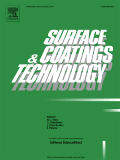
SURFACE & COATINGS TECHNOLOGY
Transforming Ideas into Advanced Coating SolutionsSURFACE & COATINGS TECHNOLOGY is a premier academic journal that has been at the forefront of research and innovation since its inception in 1986, diligently published by Elsevier Science SA. With an impressive range of studies focusing on surface and coatings technologies, the journal has established itself as a leading platform within the fields of Chemistry, Condensed Matter Physics, and Materials Science. Notably, it holds a distinguished Q1 ranking in multiple categories, showcasing its relevance and high impact in the academic community. Furthermore, it is recognized for its rigorous peer-review process and is indexed in esteemed databases, maintaining its strong position with a ranking of #17 in Surfaces, Coatings, and Films. Although the journal does not currently offer open access options, it continues to be a crucial resource for researchers, professionals, and students seeking insights into cutting-edge developments and applications in the domain of surface engineering. With a commitment to advancing knowledge across these disciplines, SURFACE & COATINGS TECHNOLOGY is an essential read for anyone interested in the latest trends and technologies shaping the industry.

Tribology Online
Bridging academia and industry in tribological advancements.Tribology Online, published by the Japan Society of Tribologists, is a dynamic open-access journal dedicated to the domain of tribology, encompassing research on surfaces, coatings, and films. Launched in 2013, this journal serves as a crucial platform for disseminating innovative findings in the field, highlighting its commitment to advancing knowledge and practice in tribological science. With an impact factor that places it in the Q3 quartile for the category of Surfaces, Coatings and Films, Tribology Online ranks 93rd out of 132 journals in its field, reflecting a growing engagement from the academic community. Open access since 2017, the journal promotes wide accessibility to research trends and technological advancements, making it an essential resource for researchers, professionals, and students pursuing cutting-edge developments in material sciences. Based in Tokyo, Japan, it aims to connect global experts and contribute to the evolution of tribological knowledge.

TRIBOLOGY LETTERS
Connecting Theory and Practice in the World of TribologyTRIBOLOGY LETTERS is a distinguished peer-reviewed academic journal published by SPRINGER/PLENUM PUBLISHERS, focusing on advancements in the field of tribology and its applications across various engineering domains. With an ISSN of 1023-8883 and an E-ISSN of 1573-2711, this journal serves as a crucial platform for disseminating cutting-edge research and technological innovations, operating from its esteemed headquarters in the United States. The journal is categorized in the Q2 quartile across multiple domains including Mechanical Engineering, Mechanics of Materials, Surfaces and Interfaces, and Surfaces, Coatings and Films, showcasing its significant impact within the respective fields. With Scopus rankings placing it in the top 25% for Engineering and top 20% for Physics and Astronomy related categories, TRIBOLOGY LETTERS continues to be an essential resource for researchers, professionals, and students looking to deepen their understanding of tribological phenomena and enhance their applications in industry and technology. While it does not currently offer open access options, the journal continues to invite high-quality contributions that contribute to the ongoing dialogue and advancement in tribological science.
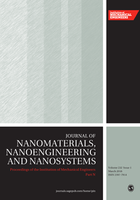
Proceedings of the Institution of Mechanical Engineers Part N-Journal of Nanomaterials Nanoengineering and Nanosystems
Exploring the Frontiers of Nanoengineering and Materials ScienceProceedings of the Institution of Mechanical Engineers Part N - Journal of Nanomaterials Nanoengineering and Nanosystems is a premier journal published by SAGE Publications Ltd that focuses on advancing the field of nanotechnology through high-quality research and critical review articles. With an ISSN of 2397-7914 and an E-ISSN of 2397-7922, this journal serves as a vital platform for researchers and industry professionals exploring the interdisciplinary applications of nanomaterials and nanoengineering. The journal has achieved a significant standing in the academic community, reflected in its Q3 ranking across multiple categories including Condensed Matter Physics, Electrical and Electronic Engineering, and Materials Science for 2023, positioning it within the 75th percentile in relevant fields. Covering topics that range from fundamental research to practical applications, the journal aims to disseminate findings that push the boundaries of materials science and engineering. With open access options available, it ensures that groundbreaking research is accessible to a global audience. The proceedings are published from 2016 to 2024 and are vital for anyone involved in the rapidly evolving domain of nanoscience.

Journal of Friction and Wear
Transforming Understanding of Friction in EngineeringJournal of Friction and Wear, published by PLEIADES PUBLISHING INC, is a pivotal resource in the field of mechanical engineering, with a particular emphasis on the study of friction, wear mechanisms, and their implications in various materials. With an ISSN of 1068-3666 and an E-ISSN of 1934-9386, this journal provides a platform for cutting-edge research and reviews that contribute significantly to our understanding in these areas. Although currently classified under Q3 in both Mechanics of Materials and Surfaces, Coatings and Films, the journal is making strides towards higher rankings, reflecting its growing influence as it publishes comprehensive analyses and innovative findings. Researchers and professionals can access vital studies, offering insights into improving material durability and performance, integral to numerous industries. This journal serves as a key reference point for students and scholars alike, supporting their quest for knowledge in the evolving landscape of material science.
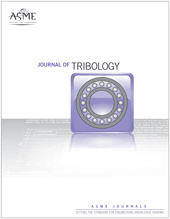
JOURNAL OF TRIBOLOGY-TRANSACTIONS OF THE ASME
Connecting Theory and Application in TribologyJOURNAL OF TRIBOLOGY-TRANSACTIONS OF THE ASME, published by the esteemed American Society of Mechanical Engineers (ASME), is a prominent peer-reviewed journal dedicated to the intricate study of tribological phenomena and their impact on mechanical systems. With an ISSN of 0742-4787 and an E-ISSN of 1528-8897, this journal has been a vital resource since its inception in 1967, covering significant developments in mechanical engineering, mechanics of materials, surfaces, and interfaces. Ranked in the Q2 quartile across multiple categories for 2023, including Mechanical Engineering and Surfaces and Interfaces, it reflects a respectable impact within the research community, with Scopus rankings highlighting its stature in various related fields. While it does not offer open access, its contributions to the understanding of wear, lubrication, and surface engineering are invaluable for researchers, professionals, and students alike, fostering advancements in both academic and industrial applications. With a commitment to disseminating high-quality research, this journal continues to be an essential platform for those seeking to push the boundaries of tribology and its applications.

SURFACE REVIEW AND LETTERS
Pioneering Studies in Surfaces and InterfacesSURFACE REVIEW AND LETTERS, published by WORLD SCIENTIFIC PUBL CO PTE LTD, is a pivotal journal in the fields of condensed matter physics, materials chemistry, and surfaces and interfaces. With an ISSN of 0218-625X and an E-ISSN of 1793-6667, this journal serves as a platform for cutting-edge research and innovative developments from 1996 to 2024. Despite its classification in the Q4 and Q3 quartiles for various categories in 2023, SURFACE REVIEW AND LETTERS emphasizes the importance of inter-disciplinary collaboration and the rapid dissemination of valuable insights, making it an essential resource for researchers and professionals eager to stay at the forefront of material science. Although currently lacking an open access option, the journal invites a wide range of submissions—fostering knowledge sharing among scholars and contributing to the advancement of the scientific community. Aspiring authors and readers will benefit from the opportunity to engage with diverse studies and methodologies, underscoring the journal's commitment to excellence in materials research.
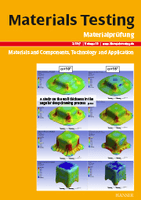
Materials Testing
Empowering Research in Mechanics of MaterialsMaterials Testing is a renowned journal published by Walter de Gruyter GmbH, serving the global scientific community in the fields of Materials Science, Mechanical Engineering, and Mechanics of Materials. With an ISSN of 0025-5300 and an E-ISSN of 2195-8572, this journal has been a significant contributor to the discourse on material performance, testing methodologies, and engineering innovations since its inception. The journal is recognized for its rigorous peer-review process and holds a commendable Q2 quartile ranking in multiple categories for 2023, showcasing its impact and relevance in the field. With open access options available, Materials Testing aims to disseminate valuable research findings and practical insights that drive advancements in technology and materials applications. By addressing the latest challenges and developments within the field, this publication serves as an essential resource for researchers, professionals, and students alike, fostering a deeper understanding of material properties and testing techniques.
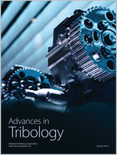
Advances in Tribology
Exploring the Frontiers of Friction and WearAdvances in Tribology is a premier open access journal published by HINDAWI LTD, focused on the rapidly evolving fields of tribology, mechanical engineering, and materials science. Since its inception in 2008, the journal has provided a crucial platform for researchers, professionals, and students to disseminate knowledge and advancements in the understanding of friction, wear, and lubrication phenomena. With an impact factor reflective of its significance, Advances in Tribology is ranked in the Q3 category for both Mechanical Engineering and Surfaces, Coatings, and Films as of 2023, situating it among the prominent journals in its field. The journal's commitment to high-quality research is evident in its rigorous peer-review process and its dedication to fostering open access, allowing for widespread dissemination of impactful research. Published in Egypt with global reach, this journal aims to bridge the knowledge gap in tribological applications and innovations, serving as a key resource for those engaged in the study and application of surface interactions.